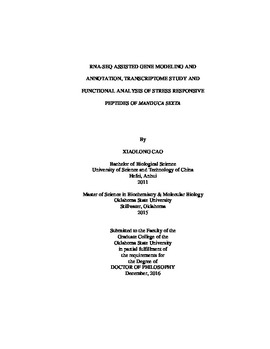| dc.contributor.advisor | Jiang, Haobo | |
| dc.contributor.author | Cao, Xiaolong | |
| dc.date.accessioned | 2018-06-25T13:38:35Z | |
| dc.date.available | 2018-06-25T13:38:35Z | |
| dc.date.issued | 2016-12 | |
| dc.identifier.uri | https://hdl.handle.net/11244/300277 | |
| dc.description.abstract | Manduca sexta is a widely used model insect. The genome sequence was determined using 454 sequencing technology, and Official Gene Set (OGS) 2.0 was generated with help from RNA-seq data and manually annotation by researchers all over the world. To improve gene models, we developed methods to compare and select gene models by MAKER2, Cufflinks, Oases and Trinity, and generate a new gene set, called MCOT 1.0. Compared with OGS 2.0, MCOT 1.0 has higher quality score as evaluated by BUSCO, and with nearly 50% more unique proteins being predicted. | |
| dc.description.abstract | The immune signaling pathways are critical for proper defense against pathogens for insects. To facilitate systematic studies of M. sexta immune system, we have identified and verified participant genes in the genome of M. sexta. We annotated 186 genes which encode 199 proteins in Toll, Imd, MAPK-JNK-p38, JAK-STAT, autophagy, apoptosis and RNA interference pathways, analyzed their evolution and mRNA levels in different tissues and different developmental stages. | |
| dc.description.abstract | To date, 67 cDNA libraries have been sequenced from different tissues and different developing stages of M. sexta. However, there is no systematic analyzation of these RNA-seq data. We examined each library, found possible contaminant reads in each of these libraries, compared library similarity based on associated genes, and analyzed gene expression in different libraries. We found that most genes were expressed in library-specific manner, and their expression patterns would help functional study in the future. Stress Responsive Peptides (SRPs) are cytokines activated under biotic and abiotic stresses, which may act as key signaling molecules for humoral and neural regulation of immune or other responses. Eight SRPs were identified in the genome of M. sexta. With similar amino acid sequence, their functions are very different. SRP6 can inhibit the growth of larvae, while SRP1 and SRP2 can induce the expression of different anti-microbial peptides. We verified activation site of SRP1 and SRP2 with MALDI-MS, and identified PAP3 as the upstream enzyme which can activate them. This study will help understand the roles of insect cytokines. | |
| dc.format | application/pdf | |
| dc.language | en_US | |
| dc.rights | Copyright is held by the author who has granted the Oklahoma State University Library the non-exclusive right to share this material in its institutional repository. Contact Digital Library Services at lib-dls@okstate.edu or 405-744-9161 for the permission policy on the use, reproduction or distribution of this material. | |
| dc.title | RNA-seq assisted gene modeling and annotation, transcriptome study and functional analysis of stress responsive peptides of Manduca sexta | |
| dc.contributor.committeeMember | Deng, Junpeng | |
| dc.contributor.committeeMember | Melcher, Ulrich | |
| dc.contributor.committeeMember | Soulages, Jose Luis | |
| dc.contributor.committeeMember | Zhang, Guolong | |
| osu.filename | Cao_okstate_0664D_14908.pdf | |
| osu.accesstype | Open Access | |
| dc.type.genre | Dissertation | |
| dc.type.material | Text | |
| thesis.degree.discipline | Biochemistry and Molecular Biology | |
| thesis.degree.grantor | Oklahoma State University | |
